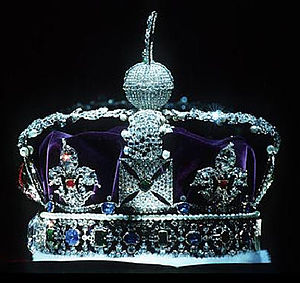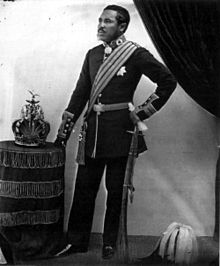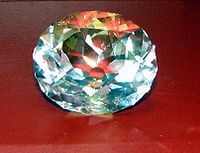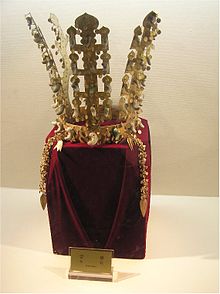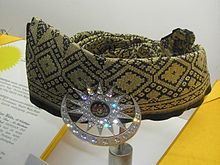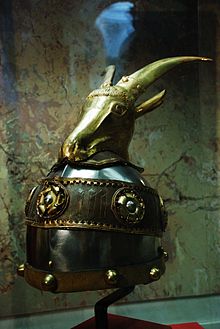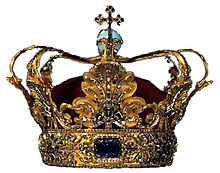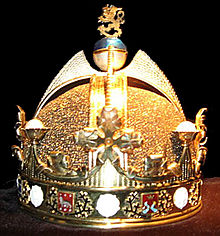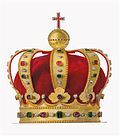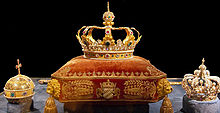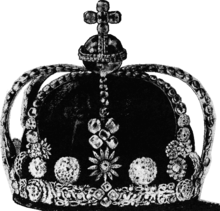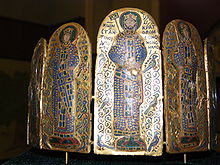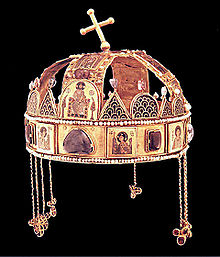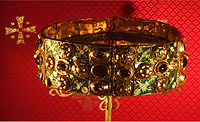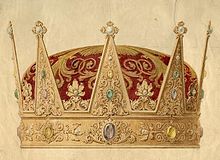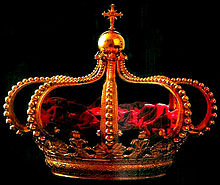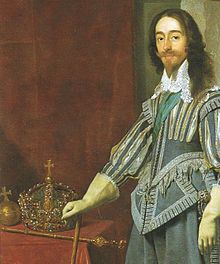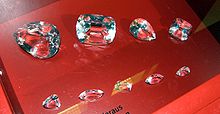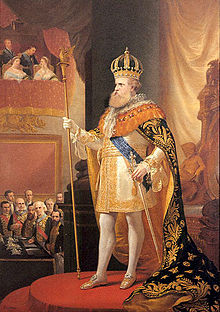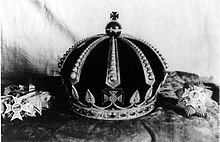- Crown jewels
-
The Imperial State Crown of the United Kingdom

Crown jewels are jewels or artifacts of the reigning royal family of their respective country. They belong to monarchs and are passed to the next sovereign to symbolize the right to rule. They may include crowns, sceptres, orbs, swords, rings, and other objects. See also: regalia.
Africa and Asia
Axum
Mostly incorporated as part of the regalia of the monarchs of the succeeding Ethiopian Empire (Please see below).
Bangladesh
The most significant objects are: ancient petrified wood (2.5 million years old) collected from lalmai and mainamati; blackstone Naga Darwaza (serpent doorway) of 10th-11th century collected from Bangarh, Dinajpur; mat made of ivory; objects of the Liberation War of Bangladesh; objects used by the martyrs of the language movement; muslin of Dhaka; items of folk art and crafts; coins of emperor Sher Shah; terracotta plaques; sculptures and collection of contemporary art including various types of statues.
Burundi
The traditional emblem of the Mwami (king) was the Karyenda drum. These holy drums were kept at special drum-sanctuaries throughout the country and were brought out for special ceremonies only. One such place is in Gitega, location of the ibwami royal court.
Central African Republic
See Coronations in Africa, Emperor Bokassa, Central African Empire.
The jewels were largely provided by the emperor's political allies in France as part of that country's infamous Francafrique policy, much to the chagrin of many progressive elements both within and without the empire. Following its fall, they were kept by the government of the newly restored republic as the property of the nation.
Egypt
- Ancient Egypt
The treasures of the Pharaohs can be seen in the Egyptian Museum in Cairo and in other museums throughout the world.
- Kingdom of Egypt
Most of the Crown Jewels of the Mehmet Ali Dynasty are at the Museum at Abdin Palace in Cairo.
Ethiopia
The principal crowns worn by Ethiopian emperors and empresses regnant are unique in that they are made to be worn over a turban. They usually have the form of a cylinder of gold (although some of the crowns at the Church of Our Lady Mary of Zion in Axum have the form of a gold cube) with a convex dome on the top with usually some form of cross on a pedestal. These gold cylinders/cubes are composed of openwork, filigree, medallions with images of saints in repousse and settings of precious stones. Fringes of small gold cones on short gold chains are also frequently used in the decoration of these crowns, both on the cylinders/cubes themselves and on the pedestal supporting the cross on the top. Also, convex circular gold medallions/disks of openwork or filigree hanging from chains over the ears are also frequently found on these crowns as well, much like the ornaments that formerly hung from sides of the Byzantine imperial crowns and which hang from the sides and back of the Holy Crown of St. Stephan of Hungary. Some crowns also appear to have a semi-circular platform for additional ornaments attached to the lower front edge of the crown (on two of the crowns of Menelik II these platforms each support a small gold statuette of St. George fighting the dragon). For a photograph of one of Menelik II's crowns;[1] a photograph of Haile Selassie wearing his imperial crown.[2]
Other parts of the Ethiopian regalia include, a jeweled gold sword, a gold and ivory sceptre, a large gold orb with cross, a diamond studded ring, two gold filigreed lances of traditional Ethiopian form, long scarlet robes heavily embroidered in gold. Each of these seven ornaments is given to the emperor after each of his seven anointing on his head, brow and shoulders with seven differently scented holy oils, the last being the crown itself.[3]
These imperial robes consist of a number of tunics and cloaks, of scarlet cloth heavy embroidered in gold and including an elbow length cape with a deeply scalloped edge, fringed in gold (the scallops on either side of the opening on the front being particularly long, giving them the appearance of a western priest's stole) and two large squares of scarlet cloth similarly heavily embroidered and fringed in gold attached to each shoulder. This cape is apparently identical in form to that also worn by the Patriarch and other higher-ranking members of the Ethiopian clergy.
The empress consort also is crowned and given a ring at her at her husband's coronation, although formerly this took place at a semi-public court ceremony three days after the emperor's coronation. Her scarlet imperial mantle has a very similar shape and ornamentation as that of the emperor, but lacking the scalloped edge and shoulder squares. The crowns of empress consorts took a variety of different forms; that of Empress Menen was modeled on the traditional form of European sovereign's crown. Other members of the imperial family and high ranking Ethiopian princes and nobles also had crowns, some resembling the coronets worn by the members of the British peerage at a British coronation, while others have uniquely Ethiopian forms.
Traditionally Ethiopian emperors were crowned at the Church of Our Lady Mary of Zion in Axum, the site of the chapel in which is kept what is believed to be the Ark of the Covenant, in order to validate the new emperor's legitimacy by reinforcing his claim to descent from Menelik I, the son of King Solomon and the Queen of Sheba, who is believed to have brought the Ark from Jerusalem to Axum. Their imperial crowns were afterwards frequently donated to the church and are kept in the church's treasury — medieval crowns and those of more recent monarchs[4] - although other monarchs have given their crowns and other regalia to various other churches. The Crown Jewels used at the coronation of Emperor Haile Selassie are kept at the museum in the National Palace (formerly the Jubilee Palace) in Addis Ababa.
Ghana and Cameroon
- Ashanti Confederacy
The symbol of the power and authority of the Asantehene or sovereign ruler of the Ashanti) is the sacred Golden Stool, the Sika 'dwa. It is used for the enthronement and symbolizes the very soul of the Ashanti as a people. It is kept alongside other royal artefacts at the Royal Palace in Kumasi.
Madagascar
Main articles: State Crown of Madagascar and Crown of Ranavalona IIIThe crown of the Malagasy sovereign was made in France for Ranavalona I. It is a large crown made from locally mined gold in c.1890 and is very heavy. In its essential form it followed the pattern of crown associated with a sovereign in European heraldry and had four arches which intersected at the top of the crown, while the circlet was made of openwork and set with precious stones and from the circlet between the arches were triangular leaf-like ornaments which also were set with precious stones (pearls?). One of the two most distinctive features of the crown was a large fan-like ornament generally described as a representation of seven of the spearhead of the traditional Malagasy warrior's spear joined together at the base, but in photographs and paintings it appear to look more like seven large feathers. The second distinctive feature is the representation of a falcon at the very top of the crown in the same position a cross would occupy on the top of an orb in the traditional crown of a Christian sovereign. The falcon is a traditional symbol of the Malagasy sovereign. The inside of the crown was filled with a large red velvet cap — red being the color traditionally associated with royalty in Malagasy tradition. This crown (termed "the massive gold state crown") and many other royal artifacts were saved when the Rova (the royal palace and royal tomb complex) in Antananarivo burned on November 6, 1995 and are now kept in the Andafivaratra Palace museum nearby. Many of the rescued items have only recently been put on display[5] There is a painting of Radama II standing next to the state crown and another of Queen Ranavalona III - the last monarch - wearing it. A recent picture of the massive gold state crown as it is today in the museum can be seen here: [1]. The smaller queen's crown last worn by Ranavalona III was taken with her into exile, first in Réunion and then later in Algiers, where she eventually died in 1917. The queen's crown can now be seen in the Musée de l'Armée in Paris.
Nigeria
The Nigerian Royal Regalia is normally kept in the capital city of the respective state. See also List of Nigerian traditional states.
List of some of the kingdoms Abeokuta - Adamawa - Benin - Borno - Edo - Fika - Gombe - Ibadan - Ijebu - Ile Ife - Ilorin - Jos - Kano - Katsina - Lagos - Onitsha - Oshogbo - Oyo - Sokoto - Tiv[disambiguation needed
 ] - Warri - Zaria (Zazzau) - Zamfara
] - Warri - Zaria (Zazzau) - ZamfaraRwanda
Close to the old capital of Butare lies the nearby Nyabisindu, formerly known as Nyanza, the traditional seat of Rwanda's monarchy. The Royal Palace at Nyanza, a domed construction made with traditional materials, has been restored to its 19th-century state and is now maintained as a museum. Further historical artifacts are kept at the National Museum in Butare.
South Africa
Tanzania
Uganda
There are several kingdoms in Uganda. During the upheavals after gaining independence, the monarchies were abolished. Only in the 1990s were the various kings restored to their thrones. Although they do not wield any political powers anymore, they are still a symbol of unity and continuance to their people. The royal regalia normally consisted of the Royal Drums, and are kept at the various palaces in the capital cities of the Ugandan states.
The kingdoms Ankole - Buganda - Bunyoro - Busoga - Toro
Pooma
The treasures of Burma´s Konbaung Dynasty are kept in the National Museum in Yangon. They include items such as the Sihasana Pallanka (Great Lion Throne), and various other items. Other items can be seen in the old capital city of Mandalay.
India
The Koh-I-Noor Diamond, mined in India in antiquity, is now set in the Crown of Queen Elizabeth (the deceased Queen Mother).
Brunei
The royal regalia of Brunei are kept in the Royal Regalia Building, which was completed in 1992, in Bandar Seri Begawan. Also housed are the Royal Chariot, the gold and silver ceremonial armoury and the jewel-encrusted crowns.
Cambodia
The jewel encrusted royal crown was lost after the coup by Lon Nol in 1970. It bore a similar appearance to the one worn by the King of Thailand. The royal crown of Cambodia was last worn at the coronation of Norodom Sihanouk in 1941.
China
The most important item for the assumption of the throne were the Imperial Seals, which gave the emperor the mandate of heaven authority. These are kept either in the Forbidden City or the National Palace Museum. Numerous crowns, robes, jewels and headwear made especially for coronations and other official events. They usually contain very large Manchurian pearls and most date from the Qing Dynasty.
Indonesia
Indonesia has various kingdoms and sultanates, all with their own unique history. The most known royal courts are distributed amongst the islands of Java, Madura, Bali, Sumatra, Kalimantan, Sulawesi, and Sumbawa. There are 23 royal courts or more which still exist today, headed either by a sultan or a ruler. Although today only HM the Sultan of Yogyakarta wields any political influence as the governor. In Indonesia the royal courts are either called Kraton or istana.
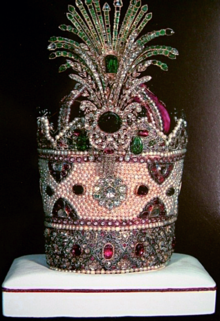 The Kiani Crown was the traditional Iranian coronation crown.
The Kiani Crown was the traditional Iranian coronation crown.
Iran (Persia)
Main article: Iranian Crown JewelsThe Imperial Crown Jewels of Iran (alternatively known as the Imperial Crown Jewels of Persia) includes several elaborate Crowns and decorative Thrones, 30 tiaras and numerous aigrettes, a dozen jewel laden swords and shields, a vast amount of precious unset gemstones, numerous plates and other dining services cast in precious metals and encrusted with gems and several other more unique items (such as a gemstone globe) collected by the Iranian monarchy during its 2,500 year existence.
For many centuries the Iranian Crown Jewels were kept in the vaults of the Imperial Treasury. However, in the early 20th century, the first Pahlavi Shah transferred ownership of the crown jewels to the state as part of a massive restructuring of the country's financial system. Later in the 1950s his son and successor, Mohammad Reza Pahlavi, decreed that the most spectacular of these items be put on public display at the Central Bank of Iran. The Imperial crown jewels of Iran is the largest jewelry collection in the world.[6]
Korea
There have been a number of crown jewels present in Korea since ancient times, spanning from the ancient Gojoseon Dynasty to the last Joseon Dynasty. Most of the regalia of these kingdoms, however, have been lost at various points in time, due to the successive rise and fall of the Korean dynasties and the subsequent and frequent raiding of Korean royal tombs and palaces by both Korean and foreign armies. The surviving regalia derive mainly from the Silla, Gaya, Baekje and Joseon dynasties.
The crowns of Silla are noted for their exquisite gold and jade workmanship, which resulted from the spread of goldsmithing technologies from Egypt and Mesopotamia to Korea via the Silk Road. The surviving Silla regalia comprise of many golden crowns, girdles, belts, necklaces, a sword, a dagger, golden shoes, earrings, and more than 35 rings and hairpins. However, the Silla custom was that every king and queen had their own set of regalia, hence the regalia for each monarch was buried with them in their tombs, warranting the creation of many different regalia depending on personal preferences, contemporary fashion and available goldsmithing technology.
The Joseon dynasty regalia comprise of formal jewel-encrusted wigs for the queen and everyday crowns encrusted with various precious gems.
The Baekje regalia are similar to the Silla regalia, but are even more arabesque and consist of magnificent girdles. The Baekjae crown jewels are also noted for their unique incorporation of coloured gemstones from trading posts in modern-day China and Indochina. During the period of the Great Korean Empire under Emperor Gojong, the imperial family commissioned many brooches, western-style diadems and tiaras to suit western-style clothes. Unfortunately, when the Japan colonized the Korean Empire in 1910, such jewels and regalia were lost to Japan.
Japan
Main article: Imperial Regalia of JapanThe Imperial Regalia of Japan (三種の神器 Sanshu no Jingi) ("Three Sacred Treasures") consist of the Holy Sword Kusanagi (草薙剣), the Holy Jewel Yasakani no magatama (八尺瓊曲玉), and the Holy Mirror Yata no kagami (八咫鏡). The sword and the mirror are kept at the Shinto shrines in Nagoya and Ise in Central Japan, and the jewel at the Kokyo Imperial Palace in Tokyo.
The enthronement cerenomy is traditionally held in Kyoto. The Imperial Throne is kept at the Gosho Imperial Palace in Kyoto.
Laos
The regalia of Laos are kept in the Royal Palace Museum in Luang Prabang.
Malaysia
Main article: Royal Regalia of MalaysiaThe royal regalia of Malaysia are kept in the Istana Negara (National Palace) in Kuala Lumpur. The regalia is worn by HM the King (ms: Yang di-Pertuan Agong), and HM the Queen (Raja Permaisuri Agong) during certain ceremonies, such as the election as head of state, HM's birthday, awards ceremonies, and the calling of parliament.
They consist of the Tengkolok Diraja (Royal Head Dress), the Queen's Gendik Diraja (Royal Tiara), the Keris Panjang Diraja (Royal Long Kris or Keris of State), the Kris Pendek Diraja (Royal Short Keris), the Cogan Alam dan Cogan Agama (Sceptre of the Universe and Sceptre of Religion), the Cokmar (Maces), the Pedang Keris Panjang dan Sundang (Royal sword, long Keris and sword Keris), the Payung Ubur-ubur Kuning dan Tombak Berambu (Yellow-fringed umbrella and tassled lances), and the Pending Diraja (Royal Waist Buckle).
Malaysia is a federal state, consisting of thirteen states and two federal territories. Out of these, nine are monarchies headed by sultans. Royal regalia and other items of the rulers are kept in the respective palaces and courts. These are:
Johore - Kedah - Kelantan - Negeri Sembilan - Pahang - Perak - Perlis - Selangor - Terengganu
Thailand (Siam)
The Royal Regalia, Royal Utensils, and the Royal Eight Weapons of Sovereignty comprise a total of 28 items. The Royal Regalia consists of the Great Crown of Victory, the Sword of Victory, the Royal Staff, the Royal Fan (or Flywhisk), and the Royal Slippers. The 28 items are traditionally presented to the Kings of Thailand at their coronation ceremonies. They are kept, amongst other royal items, at the Grand Palace in Bangkok.
Vietnam
The signs of the imperial power of the Nguyen Emperors were the Great Imperial Seal and the Sword. When Bảo Đại, the last Emperor of Vietnam, abdicated in August 1945 at Huế he is recorded to have surrendered the royal insignia to the new communist authorities. What happened to them after this is not known, but presumably they took them away, perhaps to Hanoi. In 1949 the former emperor became "Head of State" of the State of Vietnam, was not crowned, and was ousted by his Prime Minister Ngo Dinh Diem in a fraudulent 1955 referendum, and spent the rest of his life in exile. In 1968 the city of Huế was the scene of Battle of Huefierce fighting between the communist People's Army of Vietnam and Vietcong and US Marines and the Army of the Republic of Vietnam. The imperial palace was bombed, ransacked and almost completely destroyed. It is possible that the imperial insignia, if they had not been removed and taken elsewhere in 1945, were lost or destroyed at this time.
Europe
Albania
The crown of Skanderbeg, believed to have been created for the medieval king in the 15th century, was smuggled out of Albania by members of the Kastrioti family following the occupation of Albania by the Ottoman Empire. The crown eventually found its way into the collections of the Habsburg dynasty (via an Italian noble family) and currently resides in the Schatzkammer in Vienna, Austria. In 1931, King Zog of Albania made a rare foreign tour and visited Vienna in an unsuccessful attempt to repatriate the crown, presumably for a future coronation (he considered giving himself the regnal name "Skanderbeg III"). Several replicas exist in Albania, most notably at Kruja Castle.
Austria
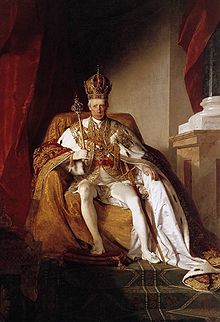 Some of the Austrian Crown Jewels being held by Franz I of Austria.
Some of the Austrian Crown Jewels being held by Franz I of Austria. Main article: Austrian Crown Jewels
Main article: Austrian Crown JewelsThe Austrian Crown Jewels (de: Insignien und Kleinodien) are kept at the Schatzkammer (Vienna), the Imperial Treasury located in the Hofburg Palace. They are a collection of imperial regalia and jewels dating from the 10th century to the 19th. They are one of the biggest and most important collection of royal objects still today, and reflect more than a thousand years of European history. The treasury can be quantified into six important parts:
- The Insignia of the Austrian Hereditary Homage
- The Austrian Empire
- The Habsburg-Lorraine Household Treasure
- The Holy Roman Empire
- The Burgundian Inheritance and the Order of the Golden Fleece
- The Ecclesiastical Treasury
The most outstanding objects are the ancient crown of the Holy Roman Emperors and also the insignia of the much later hereditary Austrian emperors. They consist of the 10th Century Imperial Crown of the Holy Roman Empire as well as the associated Orb, Cross, and Holy Lance, the Imperial Crown, the Imperial Orb and the mantle of the Austrian Empire, and the Coronation Robes of the Kingdom of Lombardy-Venetia.
- The archducal hat is kept today at the Augustinian Abbey of Klosterneuburg, in Lower Austria. See archducal hat for further information.
- The ducal hat of Styria is kept at the Landesmuseum Joanneum in Graz, Styria.
Croatia
The 11th century Crown of Zvonimir was a Papal gift to King Zvonimir of Croatia. It is thought likely to have been lost during the Ottoman invasions of the Balkans in the 16th century. The distinctive crown adorns several local flags in Croatia and Dalmatia.
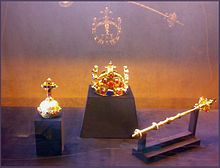 The precious Czech Crown Jewels are the fourth oldest in Europe.
The precious Czech Crown Jewels are the fourth oldest in Europe.
Czech Republic (Bohemia)
Main article: Czech Crown JewelsThe jewels (cs: korunovační klenoty), and the Crown of Saint Wenceslas of Bohemia (Svatováclavská koruna) are kept in Prague Castle (Pražský hrad) and are displayed to the public only once every (circa) eight years. Made from gold and a set of precious rubies, sapphires, emeralds and pearls, the 22-carat gold crown weighes 2.475g. The crown is named and dedicated after the Duke and Patron Saint Wenceslas I of the Přemyslids dynasty of Bohemia. The crown has an unusual design, with vertical fleurs-de-lis standing at the front, back and sides. Made from gold and precious stones, its weight is 2.475g. It was made for King Charles IV in 1346. Since 1867 it has been stored in St. Vitus Cathedral of Prague Castle. The jewels have always played an important role as a symbol of Bohemian statehood.
An ancient Czech legend says that any usurper who places the crown on his head is doomed to die within a year. In the eyes of some this was confirmed during World War II when Reinhard Heydrich, the Nazi governor of the puppet Protectorate of Bohemia and Moravia secretly wore them believing himself to be a great king, and was assassinated less than a year later by the Czech underground.[7]
Denmark
Main article: Danish Crown RegaliaThe crown jewels and other royal regalia of Denmark are kept in Rosenborg Castle in Copenhagen.
Finland
In 1918 a unique crown was designed in Finland for the proposed "King of Finland and Karelia, Duke of Åland, Grand Prince of Lapland, Lord of Kaleva and the North" (Suomen ja Karjalan kuningas, Ahvenanmaan herttua, Lapinmaan suuriruhtinas, Kalevan ja Pohjolan isäntä). However, the political situation changed before the new crown could be used in the coronation ceremony of Finland's first independent monarch. By the end of 1918 the uncrowned monarch had abdicated and Finland had adopted a new republican constitution. The crown which exists today was made by goldsmith Teuvo Ypyä in the 1990s, based on the original drawings, and is kept in a museum in Kemi where it can be seen today. The crown, which is made of silver gilt, consists of a circlet and cap decorated with the arms in enamel of various provinces of the realm. Above the circlet are two arches. Topping the arches is not a Globus Crusiger like in most European crowns, but a gold rampant lion in the form as found in the Coat of arms of Finland. Inner circumference of the crown is approximately 58 centimeters and it weight about 2 kilograms.
France
Main article: French Crown Jewels "Hand of Justice" in Louvre
"Hand of Justice" in Louvre
The surviving French Crown Jewels and main Regalia including a set of historic crowns are principally on display in the Galerie d'Apollon of the Louvre, France's premier museum and former royal palace, and scattered in different museums like the National Library of France, the Basilica of Saint Denis the Natural history museum, the Ecole des Mines or in Reims.
Brittany
The Dukes of Brittany were crowned with a royal crown said to be that of the former kings of Brittany in a ceremony designed to emphasise the royal ancestry and sovereignty of the reigning duke. After the marriage of Anne of Brittany to Charles VIII of France in 1513 Breton independence began to slip away. The last person known to have been crowned in Brittany with their royal crown was Francis III, Duke of Brittany in 1524. He was a member of the ruling dynasty of France and heir to the French throne. He died in 1536 and was succeeded as dauphin by his brother Henry. Henry became King Henry II of France in 1547 when his father, Francis I, died. Neither Henry nor any of his successors bothered to get crowned separately as Duke of Brittany but did use the title. The location of the Breton crown is unknown but it is thought to have been moved to Paris at some point. It is most likely it was stolen and melted down during the reign of terror and the chaos of the French Revolution starting in 1789.
Burgundy
The Dukes of Burgundy had a jewelled "Ducal Hat" rather than a formal crown which they wore for ceremonial occasions. This hat was lost by Charles the Bold at the Battle of Grandson in 1476 when his army was routed and his baggage train was captured by the Swiss. After the battle it came into the hands of the canton of Basle who hid it. Charles the Bold was killed at the Battle of Nancy the following year and the hat re-emerged to be sold first to the Fuggers in 1506 and then later to Maximilian I, Holy Roman Emperor. What happened to the hat after this is not known. Presumably, after this it was kept for a while by successive emperors (particularly Emperor Charles V who was also the Duke of Burgundy) but at some point it was lost.[8]
Georgia
Kartli-Kakheti
There is no information about any crown for Kartli-Kakheti predating 1798 although presumably there was one. It is likely that the ancient crown or crowns, traditionally kept at Mtskheta, were lost in 1795 when Shah Agha Mohammed Khan of Persia invaded Kartli and ravaged the kingdom.
A replacement crown was commissioned by George XII of Georgia for his coronation in 1798. It was made in Russia and deviated from the traditional Georgian design. It was a closed crown or "corona clausa" made of gold and decorated with 145 diamonds, 58 rubies, 24 emeralds and 16 amethysts. It took the form of a circlet surmounted by ornaments and eight arches. A globe surmounted by a cross rested on the top of the crown.
Following the death of George XII in 1800 the crown was sent to Moscow and deposited in the Kremlin to prevent the coronation of any of his successors. In 1923 it was presented to the National Museum of Georgia in Tbilisi but in 1930 it was once again sent back to Moscow where this time it was broken up.[9]
A sword of King Heraclius II survives and is kept at the National Museum in Tbilisi.
Imereti
The Crown of Imereti dating from the 12th century and believed to have been commissioned by David IV of Georgia was known to have been kept at the monastery at Gelati after the last king Solomon II was deposed in 1810 and Imereti occupied by Russia. It is recorded as remaining there until at least 1917 after which it disappears from the record, presumably stolen or destroyed during the communist revolution, but perhaps hidden.
Germany
Anhalt
MISSING
Baden
Grand Duke Karl II of Baden was given a crown by Napoleon I, the cousin by marriage of his wife, Stéphanie Louise Adrienne de Beauharnais. The design of the crown follows the general pattern typical of a European royal crown, but is unique in that the circlet and the arches of the crown are made of gold fabric rather than of a precious metal such as gold or silver-gilt. The precious stones which ornament this crown are in metal settings which are attached to this circlet and these arches much like brooches pinned to fabric. At the intersection of the four arches of this crown is a blue enameled orb and a cross both set with diamonds. The cap on the inside of the crown is made of the same crimson velvet which also covers the reverse sides of the arches of the crown.[10]
Bavaria
Main article: Crown Jewels of BavariaIn 1806, Napoleon I of France conquered the Holy Roman Empire. He restructured the many German states and the Duchy of Bavaria was promoted to a 'Kingdom'. The ruling Wittelsbach Duke became Maximilian I became King of Bavaria. With his new status, the King ordered new regalia to be made, which included the 35.56-carat (7.11 g) Wittelsbach Diamond, an oval Old Mine cut blue diamond. The diamond's history dates back to the 1660s and for the most part has been uneventful. The gem was offered with other Bavarian Crown Jewels in a 1931 auction at Christies in London, but apparently it did not sell, nor did it return to its display in Munich. Rumors included one that the stone had been sold illegally in 1932 through a Munich jeweller and had reappeared in Holland. Later research unveiled the fact that the gem had actually been sold in Belgium in 1951 and that it had changed hands again in 1955. In 1958 millions of visitors came to Brussels for the World Exhibition and many must have cast eyes upon the jewelry display which included a large blue diamond. But not one person appeared to have any inkling that this was in fact a missing famous gem: the Wittelsbach Diamond. Credit for the recognition of the true identity of the blue diamond must go to Joseph Komkommer, a leading figure in the Belgian diamond industry and the fourth generation of a diamond family. In January 1962 Mr. Komkommer received a phone call asking him to look at an Old Mine cut diamond with a view of its recutting. When he opened the package he received a shock — a dark blue diamond is among the rarest and most valuable of gems. Mr. Komkommer at once recognized that the diamond was one of historical significance and that it would be a tragedy to recut it. With the assistance of his son, Jacques Komkommer, he identified the diamond as the 'lost' blue diamond that was formerly owned by the House of Wittelsbach. He thereupon formed a consortium of diamond buyers from Belgium and the USA which purchased the diamond, then valued at £180,000. The vendors were the trustees of an estate whose identity remained undisclosed. Finally, the Wittelsbach was acquired by private collector in 1964. It was announced in October 2008 the diamond would be offered for auction at Christies in December. Its original Golden Fleece ornament can be seen today in the Treasury of the Residenz Palace in Munich, a blue glass replica of the Wittelsbach in place of where the diamond was set.
The Bavarian Coronation Set consists of the Crown of Bavaria, the Crown of the Queen (originally made for Maximilian's Queen, Caroline Frederika of Baden), the State Sword, the Royal Orb, and the Royal Sceptre.
Hesse
Most of the crown jewels were stolen and destroyed by US army officers at the end of World War II. See Schlosshotel Kronberg.
Liechtenstein
Main article: Ducal hat of LiechtensteinMecklenburg
MISSING
Saxony
Main article: Crown Jewels of SaxonyThe treasures of the Kings of Saxony are kept in Dresden.
Thurn and Taxis
MISSING
Prussia
Main article: Crown Jewels of PrussiaThe crown and the insignia of the Kingdom of Prussia are kept at Hohenzollern Castle in Sigmaringen, Baden-Württemberg.
Württemberg
Main article: Crown Jewels of WürttembergHoly Roman Empire
Main article: Imperial RegaliaThe Imperial Regalia like the Holy Crown of Charlemagne, the orb, the sceptre, the Holy Lance, and various other items are kept in the Schatzkammer Treasury in Vienna, Austria.
Greece
The enameled plates from the crown of the Byzantine emperor Constantine IX Monomachos, 1042–1055, made c. 1042, survive in Budapest. Main article: Crown Jewels of Greece
Main article: Crown Jewels of Greece- The crown of the Byzantine emperor Nicephorus Phocas (963-969) at the Great Lavra monastery on Mount Athos.[11]
- The enameled plates from the crown of the Byzantine emperor Constantine IX Monomachos, 1042–1055, made c. 1042, survive in Budapest.
Hungary
Main article: Crown Jewels of HungaryThe "Holy Crown of Hungary" Hungarian: Magyar Szent Korona, German: Stephanskrone, Croatian: Kruna svetoga Stjepana, Latin: Sacra Corona), also known as the Crown of Saint Stephen, was the coronation crown used by the Kingdom of Hungary for most of its existence. The Crown was bound to the Lands of the Crown of Saint Stephen, (sometimes the Sacra Corona meant the Land, the Carpathian Basin, but it also meant the coronation body, too). No king of Hungary was regarded as having been truly legitimate without being crowned with it. In the history of Hungary, more than fifty kings were crowned with it (the two kings who were not so crowned were John II Sigismund and Joseph II).
The Hungarian coronation insignia consists of the Holy Crown, the sceptre, the orb, and the mantle. Since the twelfth century kings have been crowned with the still extant crown. The orb has the coat-of-arms of Charles I of Hungary (1310–1342); the other insignia can be linked to Saint Stephen.
It was first called the Holy Crown in 1256. During the 14th century royal power came to be represented not simply by a crown, but by just one specific object: the Holy Crown. This also meant that the Kingdom of Hungary was a special state: they were not looking for a crown to inaugurate a king, but rather, they were looking for a king for the crown; as written by Crown Guard Péter Révay. He also depicts that "the Holy Crown is the same for the Hungarians as the Lost Ark is for the Jewish".
Since 2000, the Holy Crown has been on display in the central Domed Hall of the Hungarian Parliament Building.
Ireland
Main article: Crown Jewels of IrelandThe Crown Jewels of Ireland were heavily jewelled insignia of the Most Illustrious Order of St Patrick. They were worn by the sovereign at the installation of knights of that order, the Irish equivalent of the English Order of the Garter and the Scottish Order of the Thistle.
Older pre-conquest items relevant to the ancient gaelic dynasties that once ruled Ireland probably also existed. One example of this is an ancient relic called the Comerford or "Ikerrin" Crown that was discovered in 1692 but may have since been lost.[12]
Italy
- Lombardy
the Iron Crown of the Lombard Kingdom, later used as crown of the medieval Kingdom of Italy and by Napoleon Bonaparte for its coronation as King of Italy, is kept at the Cathedral of Monza. The coronation robe is kept in the Schatzkammer in Vienna, Austria.
- Kings of Italy
The Crown jewels of the Kingdom of Italy (1861–1946) are in the custody of the Bank of Italy, due to legal controversy between the Italian Republic and the Savoia family. It is not clear who is the legal owner. The value of crowns, diadems and various jewels is valued at over €2,5 Billion.
 A scepter consisting of a gilt rod topped with a red-enameled globe topped in turn by a red-enameled Florentine Lily also formed part of the regalia of the Grand Dukes of Tuscany.[13]
A scepter consisting of a gilt rod topped with a red-enameled globe topped in turn by a red-enameled Florentine Lily also formed part of the regalia of the Grand Dukes of Tuscany.[13]
- Grand Dukes of Tuscany
On being made Grand Duke of Tuscany Cosimo I de' Medici was granted the use of an open radial crown with a representation of the red Florentine fleurs-de-lis with its stamens posed between the petals in place of the ray in the front, completely covered with precious stones, by Pope Pius V, who specified that the circlet of this crown be engraved with an inscription that the crown had been granted him to wear by the Pope. On the actual crown made this inscription was place on the back of the circlet, while the front was actually covered with precious stones like the rest of the crown. A sceptre consisting of a gilt rod topped with a red-enameled globe topped in turn by a red-enameled Florentine Lily also formed part of the regalia of the Grand Dukes of Tuscany. The coronation portrait of the Grand Duke Gian Gaston de' Medici shows the same Florentine grand ducal crown closed with the pearl set arches associated with sovereignty. This crown was also used as the heraldic crown in the arms of the Grand Duchy of Tuscany.[14]
Monaco
Monaco features a heraldic crown on its coat-of-arms, but does not possess any crown jewels or regalia per se.
Netherlands
Main article: Dutch Royal RegaliaNorway
Main article: Crown Jewels of NorwayThe crown jewels, or royal regalia, of Norway are together with some other old treasures on permanent display in an exhibition next to the Nidaros Cathedral, in Trondheim.
- King's Crown:[15]
- King's Sceptre:[16]
- King's Orb: [2]
- Anointing Horn:[17]
- Sword of State:[18]
- Queen's Crown:[19]
- Queen's Sceptre:[20]
- Queen's Orb: [3]
- Crown Prince's Crown:[21]
Poland
Main article: Crown Jewels of PolandThe only surviving part of the Polish Crown Jewels is from the Piast dynasty and consists of the coronation sword known as the Szczerbiec. It is currently on display along with other royal items in the Wawel Royal Castle Museum, Kraków. Most of the Crown Jewels were plundered by foreign invaders such as the Swedes, Germans and Russians.
One of many royal crowns was made for King August II, Elector of Saxony when he became King of Poland in 1697. Since the original set was stolen, a new set was made for the coronation in Kraków. Today it is displayed in the Royal Castle in Dresden, Germany.
Portugal
The royal Crown of Portugal was made in 1817. It was created in Rio de Janeiro, Brazil, in the workshop of Don Antonio Gomes da Silva, for King John VI.
Romania
Main article: Crown Jewels of RomaniaThe Romanian Crown Jewels consist of three crowns: the Steel Crown, the Crown of Queen Elisabeta and the Crown of Queen Maria; and two scepters: the Scepter of Ferdinand I and the Scepter of Carol II. They are displayed at The National History Museum of Romania in Bucharest.[22]
Russia
Main article: Regalia of the Russian tsarsThe coronation regalia, such as the Imperial Crown of Russia, the Imperial Orb of Catherine the Great, the Imperial Sceptre with the Orlov Diamond, the Shah Diamond, and others are kept at the Kremlin Armoury and Diamond Fund in Moscow.[23]
 Two oldest Russian crowns - "Cap of Monomach" and Kazan Crown.
Two oldest Russian crowns - "Cap of Monomach" and Kazan Crown.
- Barmas of Old Ryazan, late 12th-early 13th century:,[24][25]
- Monomakh's Cap, late 13th-early 14th century:[26]
- The Crown of Kazan Tzardom of Tsar Ivan IV, mid. 16th century:[27]
- Ivory throne of Tsar Ivan IV, Western Europe, 16th century:[28]
- Orb of Tsar Boris Godunov, Western Europe, end of the 16th century:[29]
- Sceptre of Tsar Boris Godunov, Western Europe, end of the 16th century.
- Golden throne of Tsar Boris Godunov, Persia, before 1604:[30]
- Golden chain of Tsar Boris Godunov, Western Europe, the 16th century.
- State helmet of Prince Fyodor Mstislavsky, Turkey, the 16th century:[31]
- State helmets ("Jericho caps") of Tsar Michael Fyodorovich, 1620-s, master N.Davydov:[32] and[33]
- Crown of Tsar Michael Fyodorovich, 1627:[34]
- Golden chain of Tsar Michael Fyodorovich, 1nd half of the 17th century.
- Golden throne of Tsar Michael Fyodorovich, Persia, before 1642:[35]
- Orb of Tsar Alexis Mikhailovich, Turkey, 1662:[36]
- Sceptre of Tsar Alexis Mikhailovich, Turkey, 1658:[37]
- Barmas of Tsar Alexis Mikhailovich, Turkey, 2nd half of the 17th century.
- Diamond throne of Tsar Alexis Mikhailovich, Persia, 1659:[38]
- Staff of Tsar Alexis Mikhailovich, Turkey, mid. 17th century:[39]
- Pectoral cross with a chain of Tsar Theodore Alekseevich, 1662.
- "Cap of Monomakh" of the second set of Tsar Peter I Alekseevich, 1682:[40]
- Sceptre of Tsar Peter I Alekseevich, 1680s.
- Pectoral cross of Tsar Peter I Alekseevich, 1680s.
- Diamond crown of Tsar Peter I Alekseevich, 1680s:[41]
- Diamond crown of Tsar Ivan V Alekseevich, 1680s:[42]
- Altabas crown of the third set of Tsar Ivan V Alekseevich, 1684:[43]
- Silver double throne of Tsars Ivan V Alekseevich and Peter I Alekseevich, 1684:[44]
- State shield, the late 17th century.
- Crown of Empress Catherine I, 1724, (only wreck survived):[45]
- Orb of Emperor Peter II, 1727.
- Crown of Empress Anna Ivanovna, 1730, master G.W. Dunkel:[46]
- Great Imperial Crown, 1762, master J.Pauzie:[47]
- Imperial sceptre, 1762, 1774, with Orlov diamond.
- Imperial orb, 1762, master G.F.Ekart:[48]
- Maltese Crown of Emperor Pavel I, 1798:[49]
- Maltese sceptre of Emperor Pavel I, 1798:[50]
- State sword, the late 18th century.
- Small Imperial Crown, 1856, master L.Zeftigen.[51]
Serbia
Main article: Crown Jewels of SerbiaThe Karađorđević Crown Jewels of Serbia were created in 1904 for the coronation of King Peter I. The pieces were made from material that included bronze of Karađorđe's cannon. This gesture was symbolic because 1904 was the 100th anniversary of the First Serbian Uprising. They were made in Paris by the famous Falise brothers jewellery company.
Slovenia
A document known as "The Swabian Mirror" or Schwabenspiegel (c.1275) refers to the installation of the dukes of Carantania and in it mentions a crown of sorts called the "Slovenian Hat" (windischer huot). This crown was placed on the head of the duke during the enthronement ceremony. The crown or hat is described as "a grey Slovenian Hat with a grey cord and four leaves suspended from the brim". In 1358 the Habsburg Duke Rudolf IV imparted coats of arms to those provinces without them and ordered the Slovenian Hat to be placed above the arms of the Slovenian March (later called Lower Carniola and now a province of Slovenia).
A crown called the "ducal hat" of Carniola still exists.[52]
Spain
Main article: Crown Jewels of SpainThe kingdoms that would consolidate to form Spain during the 15th and 16th centuries, namely the Kingdoms of Castile and Aragon, did not have consistent coronation ceremonies. The last recorded coronation ceremony in what would become Spain occurred in the 15th century; since then, the monarchs were not crowned, but proclaimed. As such, there was decreased importance for a coherent set of crown jewels, as these are usually themselves coronation regalia.
Much of what did exist into the modern era of the regalia of Spain was destroyed in the Great Fire of Christmas Eve 1734.[53] In the 18th century, King Charles III ordered a new crown and sceptre to be made. This crown is made of golden silver, and it features half-arches resting on 8 plates bearing the emblems of the Kingdom. The crown and scepter are displayed during the opening of the Cortes (Parliament). During ceremonies of accession with a new monarch, the crown and scepter are also present, but the crown itself is never placed on the monarch's head. Today they are kept by the Patrimonio Nacional (the Crown Heritage).
Today, there are other pieces of jewelry and historically important items that would be considered "crown jewels" in other countries but are not denominated as such in Spain. In terms of jewelry, all of the jewels and tiaras worn by the members of the Spanish Royal Family are privately owned by them. More historically important elements are kept as pieces of cultural interest in different parts of Spain. For example, the personal crown used by Isabella I of Castile, her scepters, and her sword, are kept in the Royal Chapel in the Cathedral of Granada. As a consequence, this means that beyond the crown and scepter used during important occasions of the Spanish state, there is no other element of the crown jewels of Spain.
Sweden
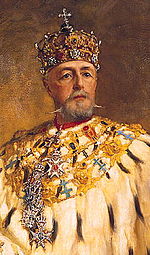 King Oscar II of Sweden and Norway in the Crown of Eric XIV, the main symbol of the Swedish king. He was the last crowned Swedish king.
King Oscar II of Sweden and Norway in the Crown of Eric XIV, the main symbol of the Swedish king. He was the last crowned Swedish king. Main article: Crown Jewels of Sweden
Main article: Crown Jewels of SwedenSweden's Crown Jewels are kept deep in the vaults of the Royal Treasury, underneath the Royal Palace in Stockholm, in a museum which is open to the public. The symbols of Swedish monarchy have not actually been worn since 1907, but are still displayed at weddings, christenings and funerals. Until 1974 the crown jewels were also displayed at the opening of the Riksdag (Parliament). Among the oldest objects are the sword of Gustav Vasa and the crown, orb, sceptre and key of King Erik XIV and numerous other sovereigns.[54]
United Kingdom
Main article: Crown Jewels of the United KingdomThe Crown Jewels of the United Kingdom are considered to be the most valuable and one of the largest jewellery collections in existence, with a number of famous diamonds and rubies including the Cullinan Diamond (the largest diamond ever found before it was cut).
England
Main article: Crown Jewels of EnglandThe crown jewels of England, and now of the United Kingdom, are kept in the Tower of London. Apart from an Ampule and Spoon they all date from after The Restoration of Charles II in 1661. The ancient crown jewels of England were destroyed by Oliver Cromwell in 1649 when he established Commonwealth of England. Among the original crown jewels were Alfred the Great's State Crown described as "Gould wyerworke set with slight stones and two little bells" which once melted down the gold it contained fetched £248 and 10 shillings, while the little 11th century crown of Queen Edith only realised £16.[55] It is considered that both these crowns date from the 11th century and the crown described as that of Alfred the Great is, in fact, the Crown of St Edward the Confessor and was renamed thus following the Reformation. There are conflicting legends that this ancient Crown of England still exists; that it was secreted by some Royalist and its hiding place was never revealed, although official sources state that the gold from this crown was recovered and used to make the present St Edward's Crown.
The State Crown of Henry VII of England included in a portrait of Charles I of England by Daniel Mytens prior to its destruction in 1649.
We know the appearance of the later State Crown of Henry VII, which shared their fate, as it is depicted in some of the portraits of Charles I, by Daniel Mytens and Van Dyck. The state crown of Henry VII had five fleurs-de-lis, five crosses and two arches topped by a gold orb and cross. The five fleurs-de-lis each had the enameled image of a saint on the central upright petal (the front fleur-de-lis had an image of the Virgin and Child, while two of the other fleurs-de-lis had images of St George and the dragon) as well as precious stones on the two curved side petals, while the five crosses and the arches were ornamented only with precious stones. The early paintings of Charles I show the front fleur-de-lis, (as, for example, in the painting by Daniel Mytens), while later paintings show the cross on the back of the crown (i. e., the crown shown from the back), which some suggest might have been a concession to Puritan objections to the representation of saints on the state crown. There were also various sceptres, swords, coronets, rings and an Anglo-Saxon comb, Some of the pieces were probably reclaimed burial regalia, including those stripped from the rich shrine of Edward the Confessor in Westminster Abbey by Henry VIII. Various medieval garments used in past coronation ceremonies were also sold off at the time, an irreparable loss.[56]
In 1660 when a replacement crown called St Edward's Crown was cast for the coronation of Charles II the gold from the aforementioned King Alfred's Crown (the original crown of Edward the Confessor) was used, so presumably even after the various jewels had been melted down strenuous efforts were made to recover their components. The present Imperial Crown of State is decorated with the principal surviving historic jewels, which were recovered at the time of the Restoration. These include Edward the Confessor's Sapphire, which is set in a Maltese cross at the top of the crown. This sapphire was once part of a ring owned by Edward the Confessor, which was buried with him in 1066. In 1101, when his shrine was opened and the ring removed, the sapphire was re-set in a crown worn by Henry I of England.
The ruby which adorns the centre of the Imperial Crown of State has a rich and dramatic history. It once belonged to a Sultan of Granada, who was murdered by Pedro the Cruel, King of Castille. He presented it to Edward, the Black Prince, in gratitude for his military assistance at the Battle of Navaretto in 1367. It was inherited by Edward's son, Richard II of England. Richard had it in his possession when he surrendered to his cousin, the future Henry IV of England in Wales in 1399. Henry later usurped the throne and Richard was murdered. Henry's son, Henry V of England, wore this ruby in the crown he wore around his helmet at the Battle of Agincourt, a bejewelled gold fleuron was struck of this same crown during the battle and lost. The ruby was similarly worn in the crown of Richard III of England at the Battle of Bosworth Field in 1485. When Richard was killed during the fighting it famously rolled under a hawthorn bush to be retrieved by Lord Stanley and placed on the head of the victorious Henry Tudor, later Henry VII of England. The Imperial Crown of State also contains pearls worn as earrings by Queen Elizabeth I of England, these are suspended from the arches of the crown.
Isle of Man
The crown jewels of the Kingdom of Man consist of a ceremonial sword known as the Manx Sword of State. The Sword of State is carried by the sword bearer before the Queens personal representative to the Isle of Man, the Lieutenant Governor, at each meeting of Tynwald day and dates from not later than the 12th Century. It is popularly said to be the sword of Olaf the Black, who became King of Mann and the Isles in 1226. Recent analysis of the sword has determined that it is a 15th-century design, and probably made in London. The blade itself is thought to have been fitted in the late 16th century, or 17th century. It is possible that the sword was made for the 1422 Tynwald meeting that was attended by Sir John Stanley. The sword has a two-edged steel blade, 29 inches long, with a hardwood hilt, 9 inches long, which tapers from the guard to the pommel. The guard is a thin steel band, 11 inches across, surmounted where the guard intersects the blade with shields carrying the 'Three Legs of Man', which also appear on the flattened pommel.
Scotland
Main article: Crown Jewels of ScotlandThe crown jewels, or 'Honours', including the Stone of Scone, are kept in Edinburgh Castle. They are the oldest surviving crown jewels in the United Kingdom and were a gift by the Pope[clarification needed] to the King of Scotland in the 16th century. They were hidden during the Interregnum. The Honours of Scotland were almost forgotten following their last use at the coronation of Charles II in 1651 until they were discovered in a chest inside Edinburgh Castle in the early Nineteenth century.
A 'golden royal crown' pre-dating the existing 'Honours' had been in existence. It is recorded that it was seized by the English authorities following a search of the luggage of the deposed John Balliol as he attempted to leave England and make his way to exile in France following his release from imprisonment in London in 1299. This crown was sent to King Edward I in London where it was probably placed with the English crown jewels at Westminster Abbey. The later fate of this crown is not entirely clear, but it may have been returned to Scotland during the negotiations between Robert I of Scotland and Edward II of England (following the English defeat at Bannockburn in 1314) or perhaps was returned to Scotland for use in the coronation of Edward Balliol when he was installed as king of Scots by England in 1332. Nevertheless, it is not in existence today.
Wales
Main article: Crown Jewels of WalesThe Honours of the Principality of Wales.
The original regalia of the Welsh princes have been lost. Llywelyn's coronet was kept after its capture with the English crown jewels between 1284 and 1649.
Vatican
- The Papal Tiara is kept in the Vatican City. For further Information, see Papal regalia and insignia.
South America
Chile
- The Kingdom of Araucania and Patagonia has a crown, presented to Prince Philippe of Araucania in 1986 by a group of Araucanian nobles. Previously, the Royal House had no crown. Made of steel and containing stones from the Rio Bio-Bio, it is on display at the Museum of the Kings of Araucania, outside the village of Chourgnac d'Ans, Dordogne, France.
Colombia
- Although not made to be worn by human beings and not a piece of regalia, the Crown of the Andes is a crown made of 18-22 carat gold and set with 450 Colombian emeralds originally made for a statue of the Virgin Mary in the Cathedral of Our Lady of the Assumption in Popayán, Colombia.
Brazil
Main article: Brazilian Imperial RegaliaThe Imperial Crown of Brazil alongside with other regalia and mementos of the Brazilian Empire are kept at the Imperial Museum of Brazil (Museu Imperial) in the former palace of Brazilian emperor Pedro II, in Petrópolis, Brazil.[57] Some pieces are also owned by the jewellery collector Aimee de Heeren, former mistress of President Getulio Vargas.
North America
Hawaii
Some of the Crown Jewels and the original Thrones of the Kingdom of Hawaii reside within the custody of the Bishop Museum. The two royals crowns were ordered from England in 1883 during Kalakaua's coronation. Worn once and only by Kalakaua and his Queen Kapiolani, they were damaged by looters during the overthrow but later restored and replace with glass jewels. Copies of the thrones can be seen at Iolani Palace. Some lie in state with the royals at the Royal Mausoleum at Mauna Ala. Feather cloak and wear are among the oldest of Hawaiian regalias: Nahienaena's Pa'u, the 180 feather skirt of Nahienaena and later the funeral attire for the dead monarch while lying in state; Kiwalao's Cloak aka Kamehameha's Cloak, the cloak won by Kamehameha I during his battle with Kiwalao; and Liloa's Kaei, the feather belt of Liloa, the 14th century King of Hawaii. Also the Kiha-pu or the War Trumpet (Conch Shell) of Kihanuilulumoku which is one generation older than Liloa's Kaei.
Mexico
Prior to the Spanish conquest (1519–1522) most of present day Mexico formed the Aztec Empire, a native American empire ruled from Tenochtitlán (present day Mexico City) by a tlatoani or "emperor". The ceremonial feathered headdress or quetzalāpanecayōtl that was worn by Montezuma II - the last reigning emperor - was seized by the Spanish Conquistadors in c.1520 and sent back to Charles V, the King of Spain as a gift. Remarkably it still survives and Montezuma's headdress can be seen at the Museum of Ethnology (inventory number 10402VO) in Vienna alongside other ancient Mexican artifacts.
Oceania
New Zealand
- Kingitanga
This Kingdom is an unofficial one, but one that has become an important one to Māori today. The current monarch is Tuheitia Paki. The crown regalia consists of a cloak.
Tahiti
The Kingdom of Tahiti had a crown. The crown was a gift from the London Missionary Society to King Pōmare III for his coronation in 1824. The original is housed in the "Museum of Tahiti and the Islands" in Punaauia.
References
- ^ "Menelik II Part II: The Post Adowa Era". Angelfire.com. http://www.angelfire.com/ny/ethiocrown/menelikII.html. Retrieved 2009-10-17.
- ^ "Haile Selassie". Geocities. Archived from the original on 2009-10-25. http://www.webcitation.org/query?url=http://www.geocities.com/Athens/Agora/6654/images/him47.jpg&date=2009-10-25+05:50:45. Retrieved 2009-10-17.
- ^ "The Coronation of His Imperial Majesty Emperor Haile Selassie I". Rasta Ites. http://www.rastaites.com/HIM/coronation.html. Retrieved 2009-10-17.
- ^ "The Collection — Treasury Of The Chapel Of The Tablet". Flickr. http://www.flickr.com/photos/adavey/2855985209/in/set-72157607017385405/. Retrieved 2009-10-17.
- ^ Royal Forums: Madagascar Royal Jewellery
- ^ http://www.rozanehmagazine.com/JanuaryFebruary06/ANationalJelleries.html
- ^ History of jewels Pictures and details (requires QuickTime)
- ^ [Daly, Kathleen and O'Day, Rosemary, France, England and Burgundy in the Fifteenth Century, The Open University, pp.63-4]
- ^ "GEORGIAN REGALIA". http://homepage.mac.com/crowns/go/avreg.html.
- ^ See picture at http://www.royal-magazin.de/german/baden/index.htm
- ^ "Byzantine Vestments". Newsfinder. http://www.newsfinder.org/site/more/byzantine_vestments/. Retrieved 2009-10-17.
- ^ Comerford Family History with Picture of Ikerrin Crown
- ^ "The Medici Family - 2 Grand Dukes of the Cadet Branch and their Women - 1530s to 1743". Paradox place. http://www.paradoxplace.com/Perspectives/Italian%20Images/Montages/Firenze/Medici%202.htm. Retrieved 2009-10-17.
- ^ "Toscana". Roberto Breschi. http://www.rbvex.it/toscana.html. Retrieved 2009-10-16.
- ^ https://info.ovf-nett.no/index.gan?id=27146&subid=0
- ^ https://info.ovf-nett.no/index.gan?id=27161&subid=0
- ^ https://info.ovf-nett.no/index.gan?id=27148&subid=0
- ^ https://info.ovf-nett.no/index.gan?id=27149&subid=0
- ^ https://info.ovf-nett.no/index.gan?id=27150&subid=0
- ^ https://info.ovf-nett.no/index.gan?id=27167&subid=0
- ^ https://info.ovf-nett.no/index.gan?d=27152&subid=0
- ^ http://www.mnir.ro The National History Museum of Romania
- ^ "Jewels of the Romanovs: Treasures of the Russian Imperial Court". http://www.alexanderpalace.org/jewels/index.html.
- ^ http://www.a-jewels.com/images/best-1.jpg
- ^ http://art.1september.ru/2003/11/no11_4.gif
- ^ http://gorod.tomsk.ru/uploads/41581/1258453431/0.jpg
- ^ http://visualrian.ru/storage/PreviewWM/1759/28/175928.jpg
- ^ http://ec-dejavu.net/images/t/throne_6.JPG
- ^ http://territa.ru/_ph/527/2/870422128.jpg
- ^ http://content.foto.mail.ru/mail/eujuve/_answers/i-351.jpg
- ^ http://durdom.in.ua/public/sys/img_4ac3ea44b8478.jpg
- ^ http://img-fotki.yandex.ru/get/3002/nadezhdmorozova.3c/0_22538_2c84399e_L.jpg
- ^ http://www.booksite.ru/enciklopedia/strate/101.jpg
- ^ http://photofile.ru/photo/semkov/3505723/large/75796365.jpg
- ^ http://s57.radikal.ru/i156/0910/ec/97d2fc8ec929t.jpg
- ^ http://pics.livejournal.com/melanyja/pic/001004rf
- ^ http://www.oboi-1test.narod.ru/museum/m_scdr.jpg
- ^ http://www.krugosvet.ru/uploads/enc/images/7/12357202997d6a.jpg
- ^ http://artgals.info/images/stories/polemika/2009/porta-kremel/porta-kremel005.jpg
- ^ http://territa.ru/_ph/527/2/288963493.jpg
- ^ http://vseromanovi.narod.ru/img/shapka_petra.jpg
- ^ http://s40.radikal.ru/i089/1003/e1/2c9a58a51ebd.jpg
- ^ http://territa.ru/_ph/527/2/140101911.jpg
- ^ http://www.pstour.ru/uplimg/4801_b.jpg
- ^ http://www.a-jewels.com/images/best-24.jpg
- ^ http://gorod.tomsk.ru/uploads/41581/1258453431/7.jpg
- ^ http://vseromanovi.narod.ru/img/korona_big.jpg
- ^ http://vseromanovi.narod.ru/img/der1.jpg
- ^ http://img0.liveinternet.ru/images/attach/c/1//49/408/49408533_5.jpg
- ^ http://www.bratstvokresta.ru/jezl.jpg
- ^ http://vseromanovi.narod.ru/img/korona_small.jpg
- ^ http://www.prah.net/slovenia/history/hat/index.htm
- ^ An image of the crown destroyed in 1734 may be seen at http://benatlas.com/wp-content/uploads/2009/04/carlos_ii_koning_van_spanje-396x608.jpg
- ^ "The Royal Court of Sweden, Regal Symbols". http://www.royalcourt.se/themonarchyinsweden/regalsymbols.4.53abbbfd7ffdfa677fff24324.html.
- ^ http://www.houstonjewelry.com/jewels2.html
- ^ http://www.englishmonarchs.co.uk/crown_jewels.htm
- ^ "Imperial Museum of Brazil". http://www.museuimperial.gov.br.
External links
- Egyptian Museum
- Kingdoms of Nigeria Arochukwu
- Virtual Rwanda Nyanza Royal Palace
- Rwanda Tourism Kigali & Butare
- The Thai Monarchy The Royal Regalia
- http://web.archive.org/web/20091026063008/http://geocities.com/threeb.rm/index.html
- On East Java Art and Culture
- Joglosermar Karaton Surakarta Hadiningrat
- Royal jewelry on [4]
Crowns English, Scottish, Welsh
and British crowns
(by chronology)Palatine Crown · Crown of Scotland · St Edward's Crown · Crown of Mary of Modena · State Crown of George I · Coronet of Frederick, Prince of Wales · Coronation Crown of George IV · Crown of Queen Adelaide · Imperial State Crown · Small diamond crown of Queen Victoria · Crown of Queen Alexandra · Coronet of George, Prince of Wales · Crown of Queen Mary · Imperial Crown of India · Crown of Queen Elizabeth · Coronet of Charles, Prince of WalesHoly Roman Empire,
German, Austrian,
Bohemian
and Italian crownsIron Crown of Lombardy · Reliquary Crown of Otto II · Crown of Otto III · Reliquary Crown of Empress Cunigunde · Reliquary Crown of Henry II · Imperial Crown of the Holy Roman Empire · Salian Funeral Crowns of Spires · Kamelaukion of Frederick II or Constance of Sicily · Reliquary Crown of Charlemagne (14th century) · Crown of St. Wenceslas (Bohemian lands) · Crown of Blanche of Valois (Bohemian lands) · Electoral Hat of Saxony · Ducal hat of Styria · Archducal hat (Archducal hat of Tyrol · Archducal hat of Joseph II) Crown of the Grand Duchy of Tuscany · Imperial Crown of Austria · Crown of Frederick I (Prussia) · Crown of Charlotte (Prussia) · Imperial Crowns of Charles VII · Napoleonic Crown of Italy · Royal Crown of Bavaria · Royal Crown of Württemberg · Royal Crown of Hanover · Grand Ducal Crown of Baden · Crown of Empress Elizabeth (Austria) Crown of Wilhelm I (Prussia) · German State Crown · Crown of Wilhelm II (Prussia)Polish crowns Crown of Bolesław I the Brave · Swedish Crown · Muscovy Crown · Hungarian Crown · Homagial Crown · Funeral Crown · Queens Crown · Crown of Augustus II · Crown of Augustus III · Crown of Maria Josepha · Płock DiademRussian crowns "Cap of Monomakh" · Crown of Kazan Tzardom · Crown of Tsar Michael Fyodorovich · Cap of Monomakh of the second set · Diamond crown of Tsar Peter I · Diamond crown of Tsar Ivan V · Altabas crown of the third set · Crown of Empress Catherine I · Crown of Empress Anna Ivanovna · Great Imperial Crown · Maltese Crown · Small Imperial CrownFrench crowns Crown of Charlemagne · Sainte Couronne · Crown of Louis XV · Crown of Napoleon I · Crown of Charles X · Crown of Napoleon III · Crown of Empress EugenieOther European crowns Crown of Crown Prince Carl (Norway) · Crown of Christian IV (Denmark) · Crown of Christian V (Denmark) · Crown of Zvonimir (Croatia) · Crown of Eric XIV (Sweden) · Crown of William I (Netherlands) · Crown of William II (Netherlands) · Crown of Norway · Crown of Portugal · Crown of the Queen of Norway · Crown of Elisabeta (Romania) · Crown of Maria (Romania) · Holy Crown of Hungary (Hungary) · Crown of Peter I (Serbia) · Crown of Martin of Aragon · Royal Crown of Spain · Crown of Greece · Papal Tiara · Crown of Rus (Ukraine) · Steel Crown of RomaniaNon-European crowns Crown of Faustin I (Haiti) · Empress Crown (Iran/Persia) · Great Crown of Victory (Siam/Thailand) · Kiani Crown (Iran/Persia) · Imperial Crown of Brazil · Imperial Crown of Mexico · Crown of Sri Vikrama Rajasinha of Sri Lanka · Pahlavi Crown (Iran/Persia) · Crown of Silla (Korea) · Crown of Hawaii · Crown of Tahiti · Crown of Madagascar · Crown of Ranavalona III · Silver crown of Emperor Tewodros (Ethiopia)See also Coronation · Crown Jewels · Heir Apparent · Heir Presumptive · King · Monarchy · Queen · Regalia · Royal FamilyCrown jewels by country Austria · Brazil · Czech Republic · Denmark · France · Germany (Bavaria · Prussia) · Greece · Hungary · Holy Roman Empire · Iran · Ireland · Japan · Malaysia · Madagascar · Netherlands · Nigeria · Norway · Poland · Romania · Russia · Serbia · Spain · Sweden · Thailand · United Kingdom (Scotland · Wales)Former or historical sovereign states shown in italics Categories:
Wikimedia Foundation. 2010.

